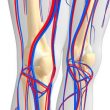Cryptogenic stroke patients with migraine have high prevalence (79%) of patent foramen ovale (PFO) with right to left shunt. However, the timing of stroke in migraineurs is not usually associated to a migraine attack. These observations are consistent with the hypothesis that the most likely mechanism of stroke in these patients with migraine is a...
Contrast Induced Kidney Injury, Infamous Problem with No Magical Solutions
In patients at high risk of developing kidney complications undergoing angiography, we did not observe benefits when administering intravenous sodium bicarbonate vs. saline, or oral N-acetylcysteine vs. placebo, as to the prevention of death, dialysis or persistent deterioration of kidney function at 90 days, or the prevention of contrast induced kidney failure. Many small studies...
Which Low-Flow, Low-Gradient Patients Benefit from Valve Replacement?
A mean gradient ≥40 mmHg, an aortic valve area ≤1 cm², or a combination of both, during dobutamine stress echocardiography, correctly qualifies as severe aortic stenosis in about half of all patients. The other half consists in cases of pseudo-severe aortic stenosis. In turn, a projected aortic valve area ≤1 cm² is a much better indicator than the...
ACC 2018 | DEFINE-FLAIR Sub-Analysis: iFR More Comfortable, Faster, and Much Cheaper
Using instantaneous wave-free ratio (iFR) to guide decisions on revascularization of intermediate lesions is cheaper than using fractional flow reserve (FFR). Based on costs from the DEFINE-FLAIR trial, researchers estimate the difference to be almost USD 1000. This should not be seen as good news for any given technology (iFR, in this case), but for physiologic...
ACC 2018 | Echocardiographic Data Help Better Choose Patients for Patent Foramen Ovale Closure
A new randomized controlled trial of patients who underwent patent foramen ovale (PFO) closure in cryptogenic stroke may provide certain morphological echocardiographic features that might allow us to better choose patients who would benefit more from PFO closure versus those for whom medical therapy would be more appropriate. Among patients with a recent cryptogenic stroke...
Surgery Seems Superior to Angioplasty in Young Patients
Long-term follow-up of patients under 50 with multivessel coronary artery disease suggests surgery outcomes are significantly better than angioplasty outcomes. This study, presented at the Society of Thoracic Surgeons’ (STS) Annual Meeting, concludes that surgery should continue as plan A when it comes to young patients with three-vessel disease. Surgeons complain that many patients never actually...
Silent Diabetes Is the New Stealthy Enemy
One in three “nondiabetic” patients who undergo angioplasty with current drug-eluting stents have an altered glucose metabolism, which is associated with a 4-fold higher risk of events, according to a study that will be published soon in JACC Intv. One in three patients is definitely one patient too many, and four times higher is definitely...
Complete Revascularization Is Beneficial in Acute MI with Cardiogenic Shock
Around half of all cases of ST-segment elevation acute myocardial infarction (STEMI) come alongside lesions in another vessel, for which the current strategy is complete revascularization in one or two steps. However, there are no large-scale studies analyzing patients who also present cardiogenic shock; we only have observational studies with inconclusive results influenced by several...
Keys to Productivity Improvement in the Cath Lab
The systematic reduction of inefficiencies in the catheterization laboratory (such as the improvement of lab room start times and room turnaround times) can definitely improve the productivity of a Department of Interventional Cardiology without forcing its members to stay in the facilities longer. As a matter of fact, work can be finished even faster with...
What Is the Prognosis for Reinterventions in Critical Lower Limb Ischemia?
Infrapopliteal (below the knee, BTK) percutaneous transluminal angioplasty (PTA) has been acknowledged as a useful strategy in chronic critical limb ischemia (CLI), but artery calcification severity results in considerable restenosis. Repeat PTA and the management of trophic lesions help with wound healing. However, this conduct has not been extensively assessed. This study enrolled 152 patients (175 limbs)...









